The first Columbus Pilgrimage was held 75 years ago on April 14 through 16 in 1940. A Pilgrimage guidebook was published that contained a section called “Historical Highlights” of Columbus. Since then much additional information about the earliest days of Columbus has come to light. So here is a corrected timeline of events leading to the founding of Columbus.
The earliest evidence of Native American people being in the Columbus area are small spear points that have been found, which are more than 11,000 years old. However, it was not until after the break up of the Mississippian culture about 600 years ago that the Indian Nations that we know began to form.
1540 – In December, Spanish explorer Hernando de Soto and his expedition crossed the Tombigbee River in the Columbus area and made their winter camp less than a day’s march away at the Indian village of Chicaca. There, probably during late-1540s, they had what was the first known pork barbeque in what is now Mississippi.
1736 – In May, a French force on its way to attack the British allied Chickasaw Indian (at present day Tupelo) camped for three days at Plymouth Bluff (present west bank of the Stennis Lock and Dam).
1737 – The French reported that the Chickasaw had a fort at Octibea, which referred to the mouth of Tibbee Creek and Plymouth Bluff area.
1771 – British surveyor Bernard Romans canoed the Tombigbee River and camped at the mouth of the Luxapilia. He commented on the beauty of Plymouth Bluff and wrote that “if placed near any town of note, I do not doubt would be much used as a walk.”
1801 – The first Euro-American settlement in northeast Mississippi occurred at Cotton Gin Port on the Tombigbee, near present day Amory, after the location of a government cotton gin there for the Chickasaw Indians.
1810 – John Pitchlynn, U.S. Interpreter for the Choctaw Nation, moved from his Noxubee River residence, near present day Macon, to Plymouth Bluff and established residence there.
1813 – With the beginning of the Creek Indian War and under threat of attack, Pitchlynn fortified his residence with a palisaded blockhouse. His small fort became known as Fort Smith. The fort becomes an important U.S. military meeting, supply and assembly point during the Creek Indian War phase of the War of 1812.
1814 – A flat boat built at Pitchlyn’s in March for the transportation of government supplies is the first reference to a flat boat being built on the upper Tombigbee. In October, Gen. Coffee led 3,000 Tennessee Militia down the St. Stephens Trace — Highway 45 from Columbus to Mobile closely follows its route — to reinforce Andrew Jackson prior to the Battle of New Orleans. One of his scouts was David Crockett. They stopped on Oct. 14 to be resupplied at Pitchlynn’s.
1815 – A cannon at Ft. Smith exploded upon being fired to celebrate the news of peace with England. Pitchlynn declared: “Well we have no further use for her — she has served us through the war, and bursted in telling us the news of peace.”
1816 – The Choctaw Treaty of 1816 opened to settlement the country east of the Tombigbee River, where Columbus is now located.
1817 – Euro-American settlers, including Silas McBee, begin drifting into the area. Andrew Jackson’s Military Road survey was completed and construction began. In the fall, a small log house was built on the Tombigbee bluff on what is now Third Street, above present day Harvey’s Restaurant. The earliest written account of the founding of Columbus was by Oscar Keeler in 1848. Keeler said the first house was built by Thomas Thomas, who had been run out of the Chickasaw Nation. Another possibility is that Thomas Cheadle built the house. He was employed by Chickasaw Agent William Cocke as a carpenter at the agency until Sept. 2, 1817. His leaving the agency just happens to coincide with the time that the future site of Columbus was selected as the Military Road Tombigbee crossing.
1818 – Several families settled in the area now included within the present day Columbus city limits and built log homes. Cotton Gin Port became the county seat of Marion County, Alabama. By mid-June of 1818, William Cocke, the Chickasaw Indian Agent 1816-1817, was living with his family at a new residence on the Tombigbee River, which may have been the Thomas house.
1819 – In June, several families arrived at the site that is now downtown Columbus and built houses. Silas McBee suggested the new town be named Columbus. It was mistakenly believed that the new town was in Alabama as the state line survey had not been completed. The county seat of Marion County, Alabama, moved to the House of Henry Greer, at present day Columbus Air Force Base. The first official reference to the “Town of Columbus” was in a Dec. 6, 1819, Alabama legislative act. The first frame house was built by Gideon Lincecum. Silas McBee was elected as Marion County’s first representive in the Alabama legislature and William Cocke’s stepson, Bartlett Sims, was the first Sheriff of Marion County.
1819/1820 – According to Keeler’s 1848 history of Columbus, Spirus Roach “occupied and kept entertainment” in the house built by Thomas Thomas. Because of the “peculiarities” of Roach’s long pointed nose, local Indians who traded at Roach’s establishment called the town “Opossum Town.” William Cocke built a large two-story log house about where the Tennessee Williams house now sits.
1820 – The Military road was completed and the U.S. Post Office that was located at Pitchlynn’s moved to Columbus. In late 1820, the survey of the state line was completed. The 1820 Census showed Columbus with a population of 107 persons, including 83 free white, 23 slave and 1 free black. Of the 83 whites, 51 were male 18 or older. The first industry was a tan yard located on what is now called the Hitch Lot. The first cemetery — the “Tombigbee Graveyard” — was established on the north side of the present day city block, on which Riverview is situated. Under the auspices of the American Board for Foreign Missions and the Presbyterian and Congregationalist Churches, the Mayhew Choctaw Mission was founded.
1821 – On Jan. 3, 1821, Miss. Gov. George Poindexter announced that “a considerable population on the waters of the Tombigbee formerly attached to Alabama fall within the limits of this state.” That area included both Columbus and Cotton Gin Port. On Feb. 9, Monroe County, Mississippi, was created and on Feb. 10 the Town of Columbus, Mississippi, was officially chartered by the legislature. The legislative act also provided for the establishment of Franklin Academy, the first free public school in Mississippi, and a 20-by-30 foot frame schoolhouse was built.
1822 – William Moore was the first Mayor of the Town of Columbus and the Cotton Plant was the first steamboat to arrive at Columbus.
1825 – William Cocke, the president of the Board of Trustees of Franklin Academy, corresponded with Thomas Jefferson, an old friend from Virginia, about education and Franklin Academy. He mentioned that there were “upwards of 60” scholars attending the school.
By the mid-1820s, Columbus was rapidly expanding. After the Choctaw Treaty of Dancing Rabbit Creek in 1830, and the opening of the Choctaw Homeland to Euro-American settlement, Columbus became a boom town. In 1830, the town banned any further construction of log homes within the town limits. Columbus was rapidly changing from a frontier village to a growing commercial center.
Rufus Ward is a Columbus native a local historian. E-mail your questions about local history to Rufus at [email protected].
You can help your community
Quality, in-depth journalism is essential to a healthy community. The Dispatch brings you the most complete reporting and insightful commentary in the Golden Triangle, but we need your help to continue our efforts. In the past week, our reporters have posted 37 articles to cdispatch.com. Please consider subscribing to our website for only $2.30 per week to help support local journalism and our community.



